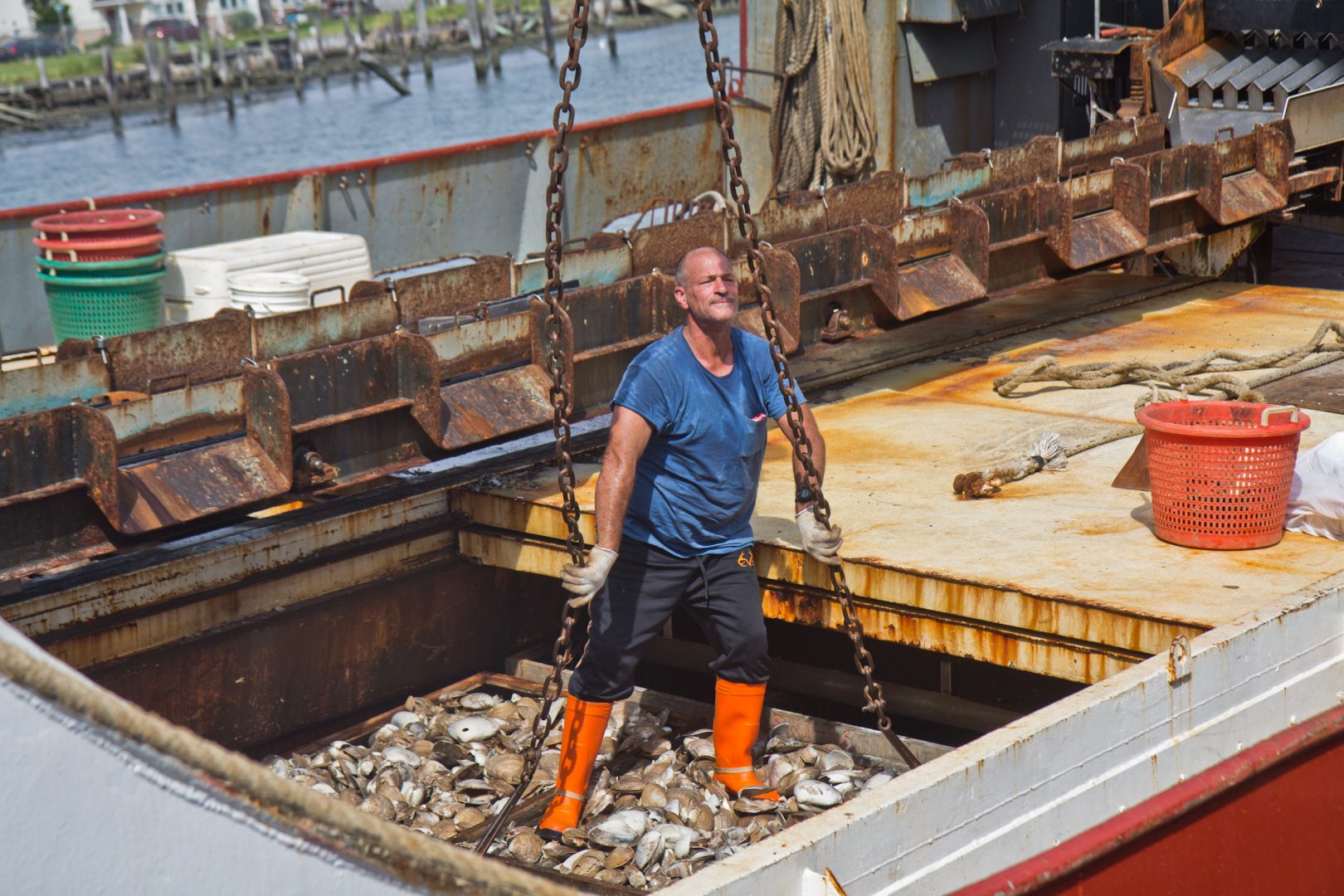
A fisherman attaches large chains to 2000 pound crates of Atlantic surf clams from the Christy at Dockside Packing in Atlantic City, N.J.
Kimberly Paynter / WHYY


A fisherman attaches large chains to 2000 pound crates of Atlantic surf clams from the Christy at Dockside Packing in Atlantic City, N.J.
Kimberly Paynter / WHYY

Kimberly Paynter / WHYY
A fisherman attaches large chains to 2000 pound crates of Atlantic surf clams from the Christy at Dockside Packing in Atlantic City, N.J.
It’s a busy day at Dockside Packing in Atlantic City. Men banging mallets against steel make repairs to the Mary Vee. A ship’s captain works a crane that offloads cages of Atlantic surf clams, each cage containing 2,000 pounds of them, dredged from the ocean bottom off the coast.
Clammers like Charlie Quintana are back from two days at sea on the Christy. “Oh, it’s just a beautiful peace of mind,” Quintana says. “I just love fishing, period, dredging, looking for clams.”
Quintana worries about climate change: He said he’s noticed a change in the fisheries because of warming oceans. But he also worries that the hundreds of thousands of acres of wind farms planned for the East Coast will limit where he can catch clams — a backbreaking job, but one that he said earns him $120,000 to $150,000 a year.
“It’ll wreck the bottom,” he said.
Captain Tom Dameron spent decades harvesting the clams that end up in cans of clam chowder on grocery store shelves or served in restaurants. Now, he’s the government relations and fishery science liaison for Surfside Foods, which employs about 100 people, including Quintana.
Standing on the dock by the vessel, Dameron explained how seawater is pumped into the ocean bottom to stir up the clam beds and a giant rake, or dredge, scoops up the larger clams.
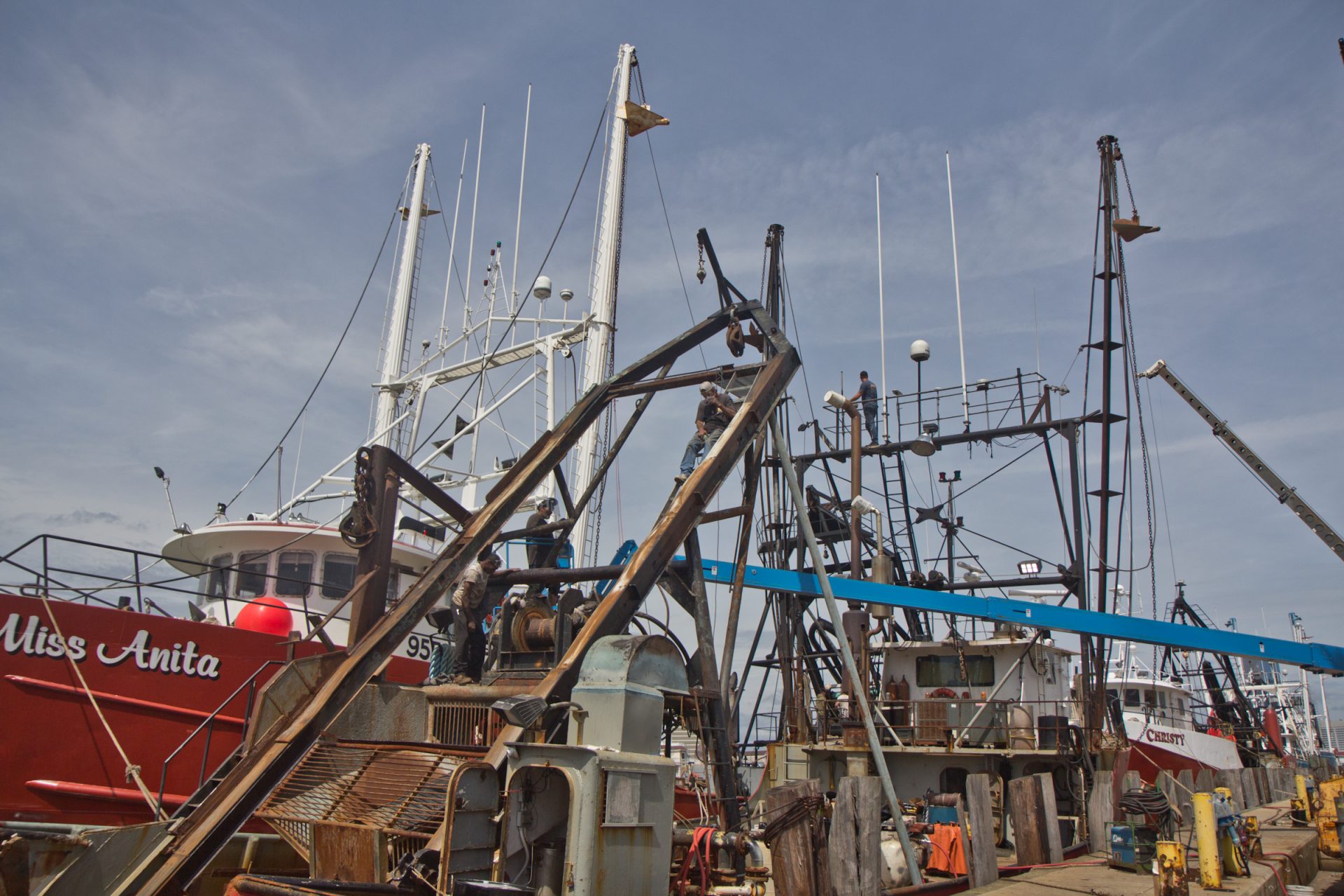
Kimberly Paynter / WHYY
Fishing fleet at Dockside Packing in Atlantic City, N.J.
“You have a knife blade similar to a blade on a plow that actually digs into the bottom,” he said. “And that is the part if there were electric cables down there, we would be afraid of that part coming into contact with the electric cables.”
Those electric cables he’s worried about would act as a giant extension cord, carrying up to 275,000 volts of wind-generated electricity to shore for distribution to homes across New Jersey and beyond. The massive wind farms that are being planned off the Jersey coast are not compatible with fishing, Dameron said.
As part of the Biden administration’s commitment to tackling climate change, it wants to develop 30,000 megawatts of offshore wind power by 2030 — enough to light up 10 million homes. Only two small wind farms now exist in the United States: the five-turbine farm off the coast of Block Island, Rhode Island, operated by a unit of the Danish energy company Orsted, and a small pilot project in Virginia operated by Dominion Energy. The Bureau of Ocean Energy Management, or BOEM, has already awarded 17 lease areas between Massachusetts and North Carolina, and this year it added another eight between Long Island and Cape May.
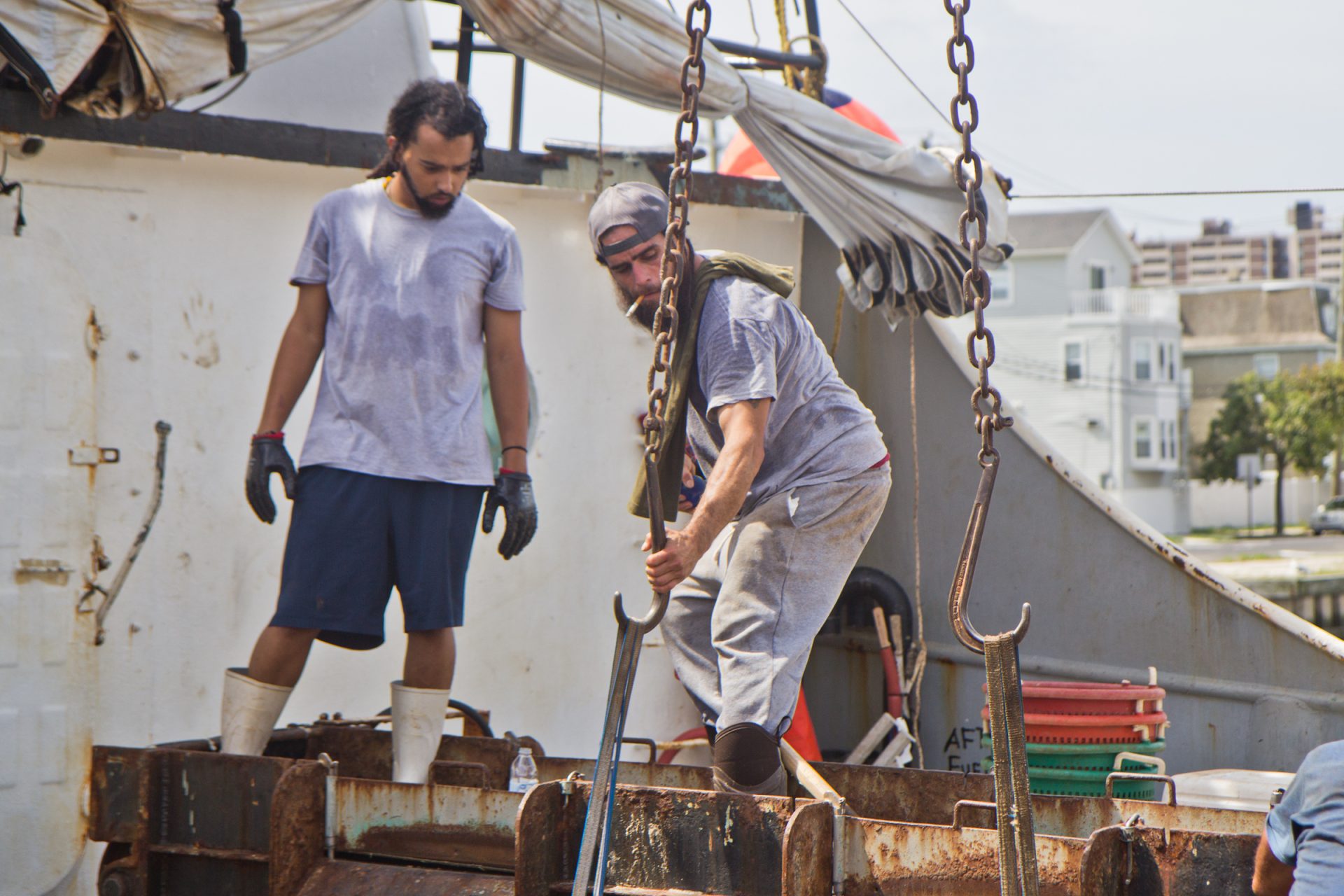
Kimberly Paynter / WHYY
Charlie Quintana (right) has been a clam fisher for 20 years, making up to $150k a year.
New Jersey was awarded the largest leasing area yet: Hundreds of turbines will rise more than 80 stories tall, like a forest of steel bolstered by a bed of rocks on the seabed and stretching over hundreds of thousands of acres 10 to 15 miles from shore.
Dameron said clammers will compete for a smaller patch of ocean.
“It’s going to lead to localized overfishing,” he said, “which will lead to the boats targeting smaller and smaller clams, which has the potential to lead to the collapse of this fishery in Atlantic City.”
New Jersey has staked its claim to lead the nation in this push to tackle climate change. But those planned wind farms off the Jersey Shore occupy some of the most fertile fishing grounds in the nation, prompting a growing battle between fisheries and wind power.
Gov. Phil Murphy has committed the state to developing 7,500 megawatts of offshore wind by 2035. It’s part of the state’s overall goal of 100% clean energy by 2050. The federal government auctions off the lease areas, which are in federal waters, more than three miles from shore. The states, which until recently have led the push for offshore wind, oversee the power contracts.
Current plans include three lease areas in New Jersey, stretching over hundreds of thousands of acres and encompassing a grid of several hundred turbines aimed to power millions of homes. But that’s just the beginning, with BOEM’s announcement this year of the eight additional leases farther out to sea between Long Island and Cape May.
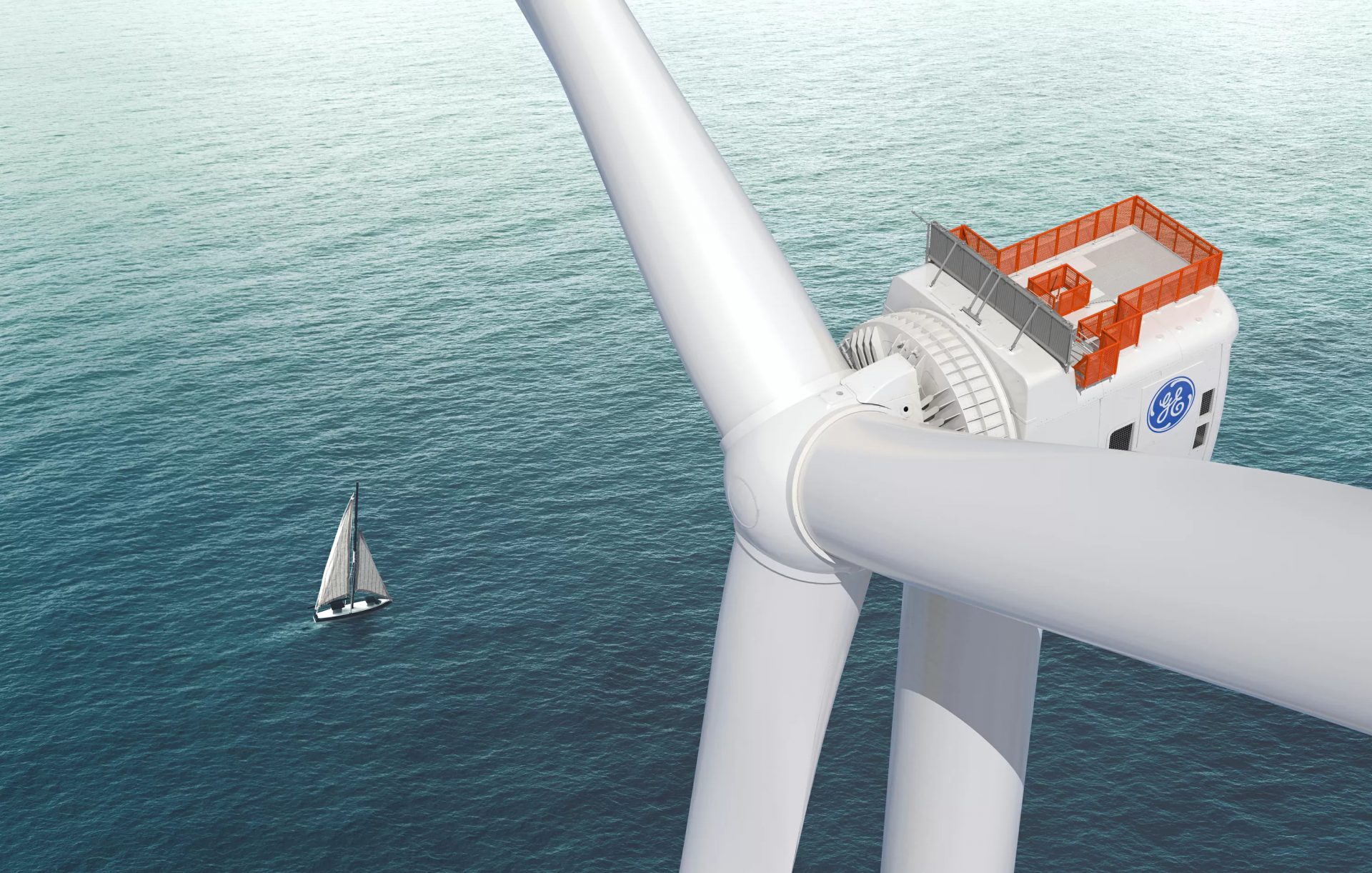
courtesy of GE
Hundreds of GE’s Halide-X turbines will rise more than 80 stories, a forest of steel covering hundreds of thousands of acres. Each will be spaced one nautical mile apart.
“It’s a massive undertaking,” said Val Stori, project director with Clean Energy States Alliance. “We’re talking about five- to seven-year timelines to get a project proposed, contracted, permitted, built, and then have the electrons flowing to shore. So these are huge investments, and they have the potential to decarbonize vast sectors of the economy. And the more that we’re looking to electrify everything, we’re looking to electrify heating, electrify transportation, perhaps one day electrify industrial processes. We will need renewable energy to do so. And that’s where the energy [for] those electrons could come from to really decarbonize economy-wide.”
It also means good jobs, Stori said. “We need lawyers. We need permitting specialists. We need scientists. We need to manufacture the turbines.”
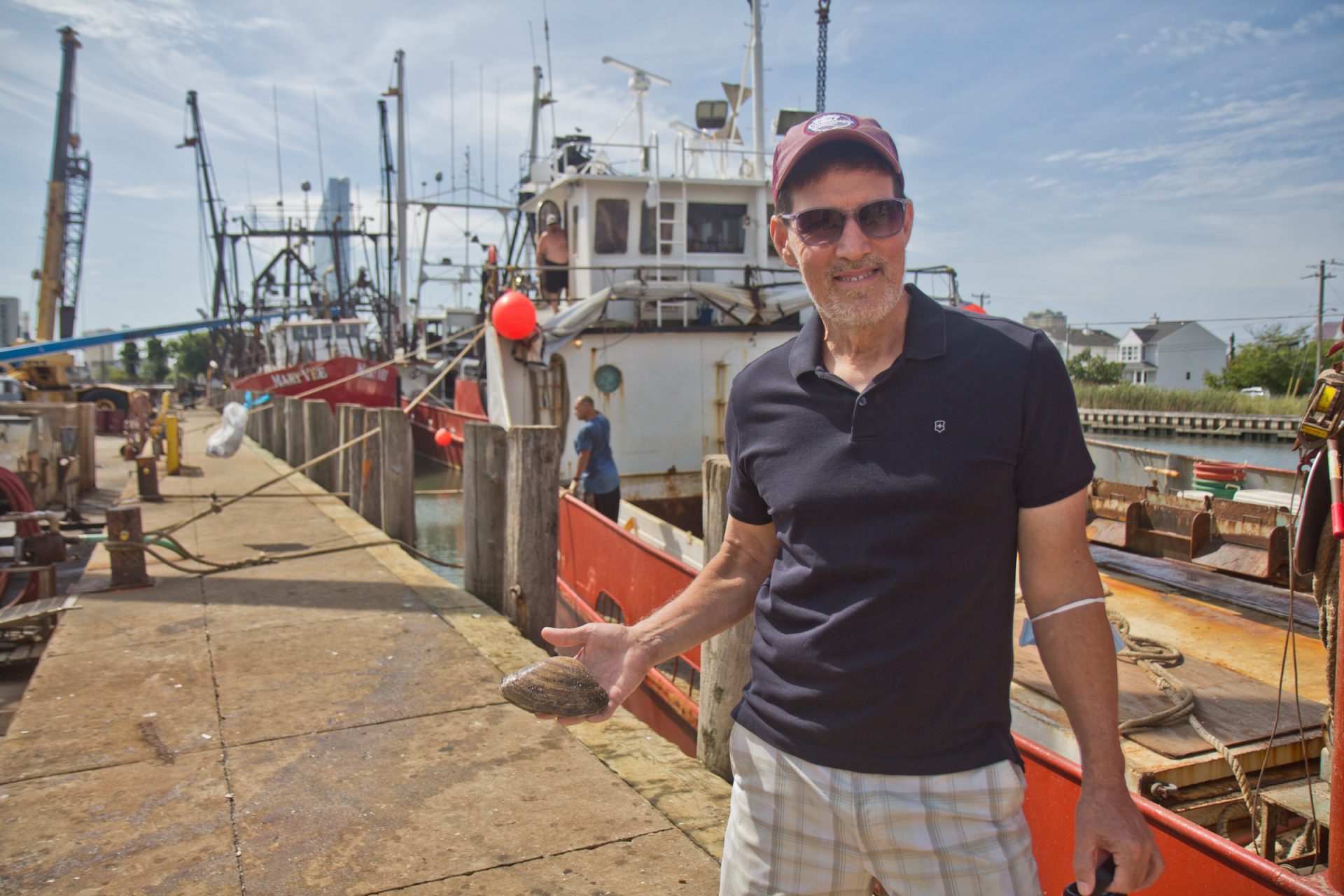
Kimberly Paynter / WHYY
Captain Tom Dameron holds an Atlantic surf clam at Dockside Packing in Atlantic City, N.J.
But fishermen like Dameron and Quintana say it would be dangerous to maneuver through the wind farms in bad weather, and they worry how the structures will affect ocean currents, temperatures, and migration patterns.
Surf clams were the first seafood to be regulated by the federal government, leading the way for what has become one of the most regulated industries in the nation. Where, when, how and how much are harvested is strictly monitored and enforced. Dameron said about 20% of the average yearly catch comes from the areas now slated to be wind farms by the federal government. In a 12-year period, he said, that added up to more than $39 million in revenue for the surf clams alone.
“We are literally fighting for the existence of the clam industry to remain in the port of Atlantic City.”
Researchers, funded by a mix of grants from the fishing industry, the New Jersey Board of Public Utilities, the Department of Energy, and the wind industry, are racing to figure out what this massive industrialization — which includes 1.7 million acres of lease area along the East Coast and more than 1,500 structures in the seabed — will mean for fisheries, marine mammals, and ecosystems.
“From my perspective as a fishery scientist, that’s a lot of ocean and a lot of fisheries and a lot of marine habitat that is on the table,” said shellfish ecologist Daphne Monroe, who works at Rutgers Haskin Shellfish Research Lab. “So it’s a lot to think about.”
Monroe recently had to shift her focus to the impact of wind. Her computer modeling shows fishermen like Dameron and Quintana are right to be fearful.
“The concentration of fishing to certain parts of the ocean will probably mean there will be a depletion of the stock,” she said. “It’ll probably mean the fleet won’t be able to operate where they are now. But it certainly hasn’t changed the planning and leasing strategy of where these wind farms are gonna go.”
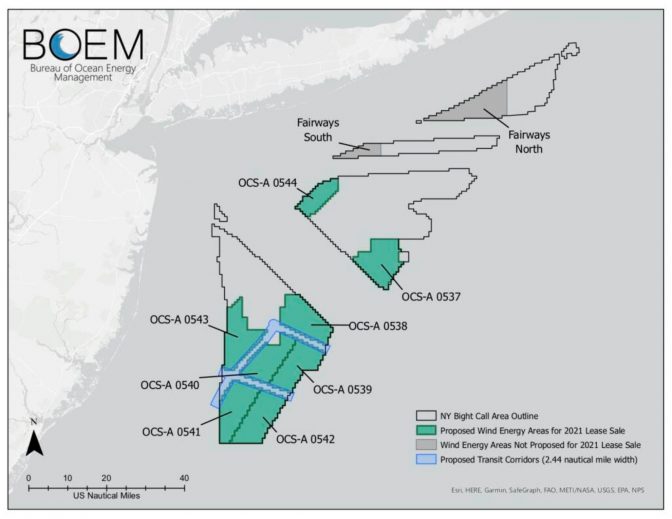
courtesy of BOEM
A map of eight additional lease areas along the Jersey coast. Current plans include 1.7 million acres of potential wind farms on the East Coast.
Orsted, the Danish company that will build and operate about 200 turbines within two of the New Jersey offshore lease areas, said the fishermen will be able to fish between the structures, which will be spaced one nautical mile apart. The third lease area, Atlantic Shores, is a joint operation of Shell and EDF Renewables and has a footprint of 183,353 acres between Atlantic City and Barnegat Light.
Orsted’s Maddy Urbish said the company believes it can coexist with the fishing industry.
“In terms of some of the concerns about the trawling, the undersea cables are buried quite deep. And we have no interest in having any equipment caught on them either.”
Urbish said an even greater threat to the fishery is climate change. There’s some evidence that warming oceans are already having an impact on the clams and scallops along the coast. That’s not to say these wind farms alone will solve those problems, but proponents say the race to build renewables is a race against mass extinction in general.
It’s a dilemma that researcher Daphne Monroe knows well.
“It’s one of those interesting tradeoffs, right. Climate change, we have to do something. Green energy is an option, but we also have sustainable fisheries that are some of the most efficient ways of producing proteins for human consumption. So, there’s a balance to be struck.”
Another fear is what could happen to a unique feature of New Jersey’s coastal fishery — the “cold pool.” Though surface waters warm each summer, lower parts of the mid-Atlantic ocean don’t mix very much with the warmer surface waters unless there’s a strong storm like a hurricane. So that deeper, colder water acts as a refrigerator for species like clams and scallops, along with bottom fish like summer flounder, or fluke.
In fact, the same ecosystem that makes fishing along the Jersey coast so lucrative, its flat sandy bottom, makes it ideal to construct a wind farm. But it’s unclear whether the wind turbines will affect that mix of ocean temperatures for better or for worse, or whether they will shift migration patterns.
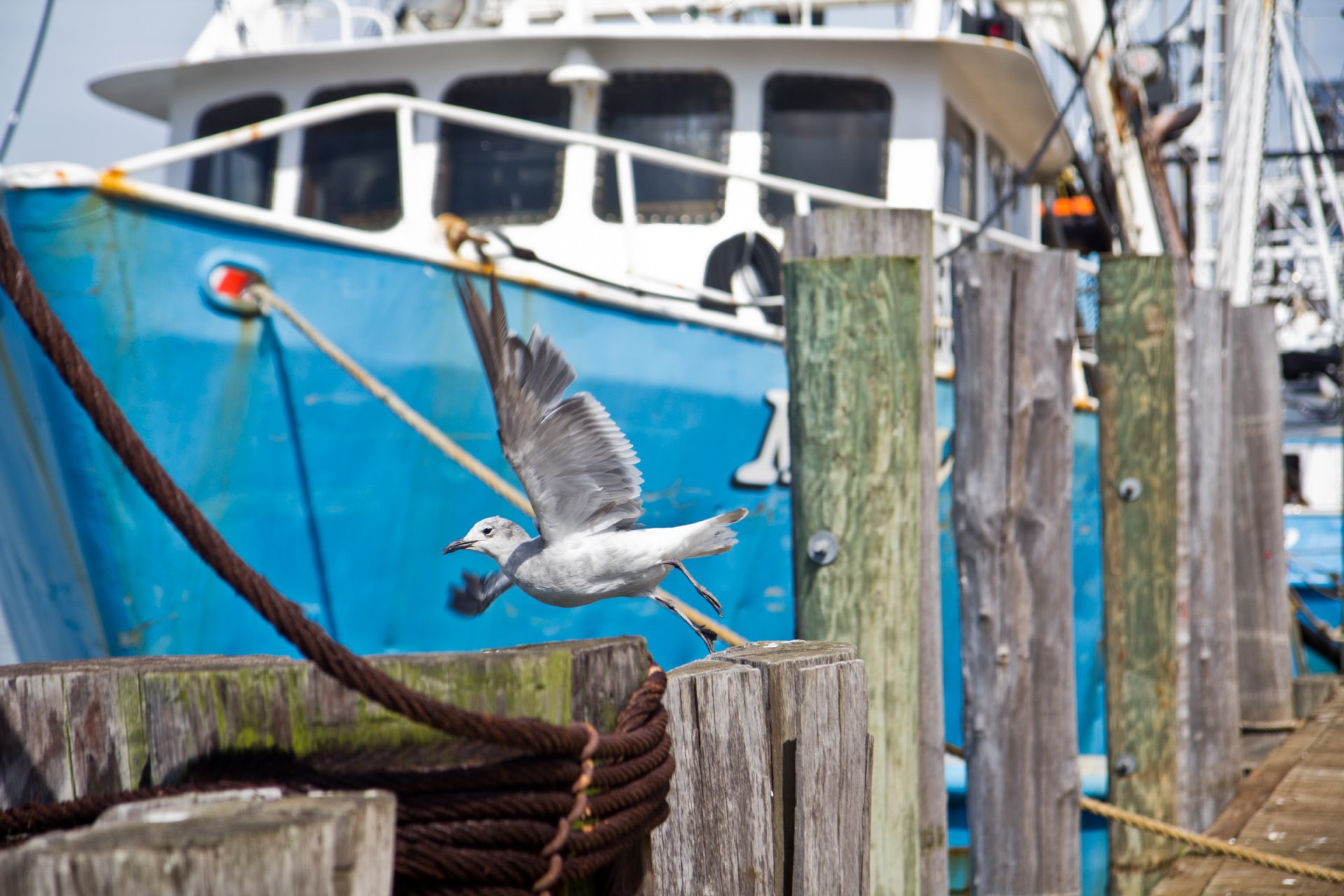
Kimberly Paynter / WHYY
A gull patrols Dockside Packing in Atlantic City, N.J.
Travis Miles, a meteorologist and physical oceanographer at Rutgers University, said that in the summertime, the mid-Atlantic ocean is one of the most highly stratified and stable water columns. Warm on top, cold on the bottom, with very little mixing. He said we can learn some things from the large wind farms that have been built in the North Sea, but that it’s a very different ecosystem.
“Europe has very strong tidal currents,” he said. “Tides happen every day, twice or more, and those strong currents can cause mixing. The faster the water goes past a structure, the more mixing. The mid-Atlantic has very weak tides, what usually causes mixing are very strong storms, cyclones, or nor’easters.”
The Science Center for Marine Fisheries funded Miles to do research on both the impact of the North Sea wind farms and local impacts. He recently published his results in a peer-reviewed journal, Marine Technology Journal.
“We don’t have a final answer,” Miles said. “We won’t have a final answer until these farms are built.”
It’s a refrain you hear from researchers looking to predict the impact on fisheries.
“There’s a balance of factors,” Miles said. “Structures, any structure in the water, including oil rigs, have the potential to cause additional ocean mixing.”
That’s because when currents move past those large, 35-foot-diameter monopile foundations and the scour, or rocks, that surround them on the seabed, it could change how the cold pool mixes with the warmer surface water. Winds also play a part in how the ocean mixes.
“However, you are also extracting wind from the atmosphere through the turbines,” Miles said. “So there’s a flip side where you have less wind to cause mixing.
“How do those two things balance out? Do we end up with a little bit more mixing or a little bit less?”
Still, Miles said, there are some indications that climate change, and the resulting warming of the ocean, could also be affecting the cold pool. Ocean acidification is also destructive to the shellfish, which can’t move.
Teasing all of this out is a massive undertaking for researchers like Monroe and Miles. Orsted and Shell have data-collecting buoys and undersea robots, which they promise to share with researchers. The impact on the endangered right whales is also under review, and construction will be timed to avoid their migration.
“I’m 90 feet above sea level, and my house flooded in Ida,” Miles said. “I’m seeing the personal impact of massive precipitation linked to climate change. We have to do something. There are unknowns, people shouldn’t be left out. But I also think we can’t wait on solutions either. It’s achievable, people can come together.”
The fishing industry says it’s not against offshore wind — after all, it, too, knows the dangers of climate change. But it also says the rush to build wind has left the industry with no seat at the table.
“The problem that we’re finding is our administration on the federal level has said, ‘Make this happen,’” Dameron said. “Our governors in New York and New Jersey have said, ‘Make this happen.’”
A fishing industry group, the Responsible Offshore Development Alliance, or RODA, recently filed a lawsuit challenging the BOEM permits for the Vineyard Wind 1 project off the coast of Massachusetts. The lawsuit says that the federal government ignored fishing industry testimony at public hearings, and that its actions have violated the Clean Water Act, the National Environmental Policy Act, the Endangered Species Act, the Outer Continental Shelf Lands Act, the Marine Mammal Protection Act, and the Merchant Marine Act of 1920.
Meanwhile, the Biden Administration is reviewing how to compensate the fishing industry for any losses.
StateImpact Pennsylvania is a collaboration among WITF, WHYY, and the Allegheny Front. Reporters Reid Frazier, Rachel McDevitt and Susan Phillips cover the commonwealth’s energy economy. Read their reports on this site, and hear them on public radio stations across Pennsylvania.
(listed by story count)
StateImpact Pennsylvania is a collaboration among WITF, WHYY, and the Allegheny Front. Reporters Reid Frazier, Rachel McDevitt and Susan Phillips cover the commonwealth’s energy economy. Read their reports on this site, and hear them on public radio stations across Pennsylvania.
Climate Solutions, a collaboration of news organizations, educational institutions and a theater company, uses engagement, education and storytelling to help central Pennsylvanians toward climate change literacy, resilience and adaptation. Our work will amplify how people are finding solutions to the challenges presented by a warming world.